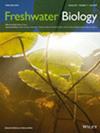Longevity, Not Stream Flow, Explains Variation in Freshwater Mussel Growth Rates Across Four Rivers
IF 2.7
2区 生物学
Q2 ECOLOGY
引用次数: 0
Abstract
- Freshwater mussels (Bivalvia: Unionida) are among the most imperilled freshwater taxa. Yet, there is a lack of basic life history information for mussels, including data on their growth and longevity. These data help inform conservation efforts, as they can indicate whether species or populations may be vulnerable to decline and inform which species may be best adapted to certain habitats. We aimed to quantify growth and longevity in five mussel species from four river systems in the southeastern United States and test whether growth was related to stream flow. We also interpreted our findings in the context of life history theory.
- To model mussel growth and longevity, we cut radial thick sections from the shells of mussels and used high-resolution photography to image the shells. We identified annual growth rings (annuli) and used von Bertalanffy growth models to estimate growth rate (K) and maximum age (Amax) across 13 mussel populations. We then used biochronological methods to remove age-related variation in annual growth in each shell. We tested whether annual growth was correlated with stream flow using discharge-based statistics.
- We found substantial variation in K and Amax among species and among populations of the same species. K was negatively related to Amax. We did not find consistent correlations between annual growth and stream flow.
- Our estimates of K and Amax align with previous studies on closely related species and populations. They also match the eco-evolutionary prediction that growth rate and longevity are negatively related. Life history theory predicts that short-lived species with higher growth rates should be better adapted to environments with cyclical disturbance regimes, whereas longer-lived species with low growth rates should be better adapted to stable environments. The lack of correlation between annual growth and stream flow suggests that mussel growth may be limited by other factors in our study system.
- While some species seem to have relatively narrow ranges for growth and longevity, other species show wide variation among populations. This highlights the need for species- and population-specific conservation efforts. Fundamental life history information can be integrated with other species traits to predict how freshwater taxa may respond to ecological threats.
寿命,而不是水流,解释了四条河流淡水贻贝生长速度的变化
淡水贻贝(双壳门:联合门)是最濒危的淡水分类群之一。然而,缺乏贻贝的基本生活史信息,包括它们的生长和寿命的数据。这些数据有助于为保护工作提供信息,因为它们可以表明物种或种群是否容易受到衰退的影响,并告知哪些物种可能最适合某些栖息地。我们的目标是量化来自美国东南部四条河流系统的五种贻贝的生长和寿命,并测试生长是否与溪流流量有关。我们还在生活史理论的背景下解释了我们的发现。为了模拟贻贝的生长和寿命,我们从贻贝的外壳上切下径向厚的部分,并用高分辨率的摄影技术对外壳进行成像。我们确定了13个贻贝种群的年轮(annuli),并使用von Bertalanffy生长模型估计了贻贝种群的生长速率(K)和最大年龄(Amax)。然后,我们使用生物年代学方法去除每个壳的年生长与年龄相关的变化。我们使用基于流量的统计来测试年增长率是否与河流流量相关。K和Amax在不同种间和同一种居群间存在较大差异。K与Amax呈负相关。我们没有发现年增长率和河流流量之间的一致相关性。我们对K和Amax的估计与之前对密切相关的物种和种群的研究一致。它们也符合生态进化预测,即生长速度和寿命呈负相关。生命史理论预测,具有较高生长速率的短命物种应该更好地适应周期性扰动的环境,而具有较低生长速率的较长寿物种应该更好地适应稳定的环境。在我们的研究系统中,贻贝的年生长和流量之间缺乏相关性,这表明贻贝的生长可能受到其他因素的限制。虽然有些物种的生长和寿命范围似乎相对较窄,但其他物种在种群中表现出广泛的差异。这凸显了对特定物种和种群的保护工作的必要性。基本的生活史信息可以与其他物种特征相结合,以预测淡水分类群如何应对生态威胁。
本文章由计算机程序翻译,如有差异,请以英文原文为准。
求助全文
约1分钟内获得全文
求助全文
来源期刊

Freshwater Biology
生物-海洋与淡水生物学
CiteScore
5.90
自引率
3.70%
发文量
162
审稿时长
2 months
期刊介绍:
Freshwater Biology publishes papers on all aspects of the ecology of inland waters, including rivers and lakes, ground waters, flood plains and other freshwater wetlands. We include studies of micro-organisms, algae, macrophytes, invertebrates, fish and other vertebrates, as well as those concerning whole systems and related physical and chemical aspects of the environment, provided that they have clear biological relevance.
Studies may focus at any level in the ecological hierarchy from physiological ecology and animal behaviour, through population dynamics and evolutionary genetics, to community interactions, biogeography and ecosystem functioning. They may also be at any scale: from microhabitat to landscape, and continental to global. Preference is given to research, whether meta-analytical, experimental, theoretical or descriptive, highlighting causal (ecological) mechanisms from which clearly stated hypotheses are derived. Manuscripts with an experimental or conceptual flavour are particularly welcome, as are those or which integrate laboratory and field work, and studies from less well researched areas of the world. Priority is given to submissions that are likely to interest a wide range of readers.
We encourage submission of papers well grounded in ecological theory that deal with issues related to the conservation and management of inland waters. Papers interpreting fundamental research in a way that makes clear its applied, strategic or socio-economic relevance are also welcome.
Review articles (FRESHWATER BIOLOGY REVIEWS) and discussion papers (OPINION) are also invited: these enable authors to publish high-quality material outside the constraints of standard research papers.
 求助内容:
求助内容: 应助结果提醒方式:
应助结果提醒方式:


